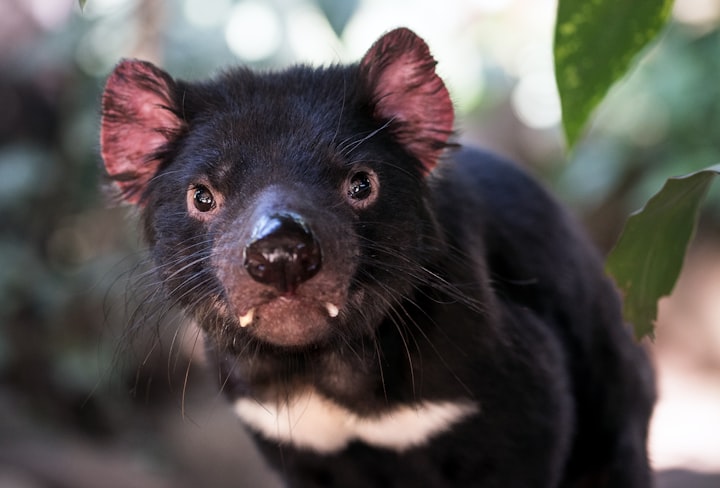The Tasmanian Devil Population is Being Decimated by Ghost Cancer
Most cancers come from a patient’s own cells, but exceptions are terrifying.

Though I don't study any of the cancers I'll mention here, I have spent almost a decade of my life doing cancer research at Cornell University, and some aspects of cancer biology can still disturb me.
But it's also extremely fascinating!
If you read the subtitle, you might be thinking, “What about human viruses that cause cancer? Aren't those relatively common?”. And that's true! Probably the best known are some strains of the human papillomavirus (HPV) which can cause cervical cancers.
HPV works by infecting a human cell and suppressing a protein called P53, also known as a tumor suppressor gene. Without it functioning properly, the infected cells will grow out of control and this can lead to cancer. However unnerving as this might be, the cancer is still made of cells from the patient.
Actually, to cause even more delay before my main topic, another interesting tidbit that shocks a lot of people is that humans aren’t the only species that gets cancer.
In fact, we're not even the only major class of organisms that can get it! Plants and trees can develop it too. Similar to the HPV example, there’s actually a bacteria that infects some trees and produces growth signals. The infected tree keeps making more and more tree cells, and so the bacteria have a lovely spacious home until the tree dies. This parasitic relationship is actually the source of some of the most expensive and beautiful wood in the world, known as burl, prized because of how unique the grain pattern can be after the uncontrolled tree-cell growth.

On the animal side, if you ever thought that cancer was only caused by human-made toxins, you should know that dinosaurs got cancer too.
Scientists have found dinosaur fossils with osteosarcoma, a bone cancer. They probably got other sorts too, but we don't find many soft-tissue fossils.
The general disease of uncontrolled cell growth has probably been around as long as multicellular life has existed on this planet. The same cellular machinery that drives normal, necessary cell growth, when knocked a bit out of whack by mutations, can lead to cancerous growths. This can happen by bad luck or the influence of something external like chemicals, viruses, or bacteria.
Okay, fine, nice! But get to the point!
What about ghost cancers killing Tasmanian devils?

Sorry, I lied. No ghosts.
Well… I guess science can't really prove or disprove that part, so you can decide if ghosts are a part of this story or not.
What is a part of this story is that the Tasmanian devil... the one who still shows up and wipes out entire populations of its fellow creatures... has been dead for decades.
But its cells are still growing.
As a science-minded biologist, I tend to think of Tasmanian devils as though an angry feral cat mated with a rabid Chihuahua and that somehow produced a tiny insane bear. But to be honest, I don’t know much about their behavior beyond not to pet wild ones... Though I hear domesticated ones can be quite cuddly!

The one behavior that I am aware of is that they tend to bite each other in the face.
Usually, this should just lead to scaring or maybe an infection. However, at some point in the past, one poor devil had facial cancer. When performing one of those little love nips, some of those cancer cells became lodged into the face of its target.
And the cells kept growing.
Usually, the immune system would recognize these cells as foreign cells. Foreign cancer cells like that shouldn’t grow unless an animal is severely immune-compromised, and we still don't know exactly why these do... But they do grow aggressively and have a lowered expression of some essential proteins that would normally help the immune system recognize them.

And so they kept growing until that host died. Even worse, before it died, that new host passed the cells to a new cuddly devil face. And on, and on.
The disease, known as Tasmanian Devil Facial Tumor Disease (DFTD), apparently first arose in the early to mid-90s, with the first case documented in 1996. We know that most of the tumor cells come from the same long-dead devil thanks to DNA testing. However, it was more recently confirmed that at least one other lineage has popped up. So some of the tumors actually come from the cells of a second devil, now also long dead.
Unfortunately, this isn’t just some rare interesting disease. It’s actually become so aggressive that it's threatening to wipe out the entire population of these not-so-cuddly-but-still-very-cute little guys, and they're definitely worth saving.
If you're interested in learning more, you can check out this site and consider donating to their cause. The Save the Tasmanian Devil Program has been around since 2003 and they're still working hard to save the world's largest carnivorous marsupial!
(I threw in that last fun trivia fact as a reward for reading all the way to the end. Thank you and I hope you enjoyed the read!)
About the Creator
Tim Pierpont
Insta - @tmpierpont
A human, with fingers and hands. Enjoys using them to create things.






Comments
There are no comments for this story
Be the first to respond and start the conversation.